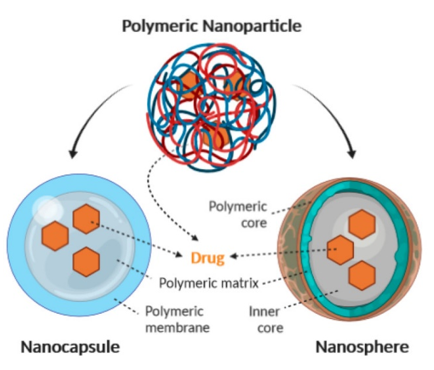Polymeric Nanoparticle Characterization Using the iEM Platform
The iEM Platform is a powerful and versatile platform for the analysis and characterization of nanoparticles, viral-based biotherapeutics, and other applications in biotherapeutic development and production. In addition to lipid nanoparticles (LNPs), we also offer a reliable and professional characterization of polymeric nanoparticles in the R&D, manufacturing, and quality control. In the past decades, polymeric nanoparticles have attracted considerable interest and have been widely used as vehicles for controlled drug delivery. As a promising drug delivery system, Polymeric nanoparticles have many advantages, including intrinsic biocompatibility and biodegradability, lack of toxicity, easy surface modifications, low cost of synthesis, and so on.
 Fig1. Schematic representation of the
Fig1. Schematic representation of the
structure of nanocapsules and
nanospheres. (Zielińska, A., et al ., 2020)
Polymeric Nanoparticles
Polymer nanoparticles are colloidal particles with sizes ranging from 10 to 1000 nanometers synthesized by synthetic or natural polymers. Due to their striking physicochemical properties (including size, surface charge, hydrophobicity, and hydrophilicity), polymeric nanoparticles can load active compounds that are entrapped within or surface-adsorbed onto the polymeric core. Polymeric nanoparticles hold noteworthy assurance for targeted delivery of drugs for the treatment of several disorders. Compared to lipid nanoparticle systems, polymeric nanoparticles are more cost-effective and easier to up-scale production with their long stability profiles. There are two types of polymeric nanoparticles, including nanospheres and nanocapsules.
Advantages of polymeric nanoparticles as drug carriers,
- The potential use for controlled release.
- The ability to protect drugs and other molecules from the environment.
- Improve the bioavailability and therapeutic index of drugs and other molecules.
Polymeric Nanoparticle Characterization at iEM Platform
Polymeric nanoparticles may differ in physical properties, in terms of their composition and concentration, as well as in size, shape, surface properties, and so on. A good understanding of physical parameters could help predict the behavior of polymer nanoparticles in vivo , thus improving efficacy and facilitating applications. In general, polymeric nanoparticles include nanospheres (a matrix system) and nanocapsules (a reservoir system), which have different morphologies. Nanospheres have a spherical shape, are based on a compact polymeric network where the active substance may be retained inside the polymeric matrix or absorbed into the polymer. Nanocapsules consist of an oily core that usually dissolves the drug (lipophilic drugs), surrounded by a thin polymeric envelope that controls the release of the drug from the core. Cryo-transmission electron microscopy (cryo-TEM) has been employed to provide distinguish between nanospheres and nanocapsules.
Creative Biostructure" services for analyzing polymeric nanoparticle quality attributes, including,
- The size, shape of polymeric nanoparticles.
- Agglomeration state and growth kinetics of polymeric nanoparticles.
- The internal nanostructure of nanocapsules, such as the thickness of the nanocapsule wall.
Since polymeric nanoparticles are promising drug carriers, their characterization is important in assessing the health and safety hazards and controlling the manufacturing process. Based on our advanced platform and professional experts, we are capable of providing high-resolution images of a wide array of samples, including polymeric nanoparticles. If you would like to know more about our unique platform, our solutions, or company policy, then please do not hesitate to contact us . We look forward to talking to you.
Reference
- Zielińska, A., et al . (2020). "Polymeric nanoparticles: Production, characterization, toxicology and ecotoxicology." Molecules , 25(16), 3731.

